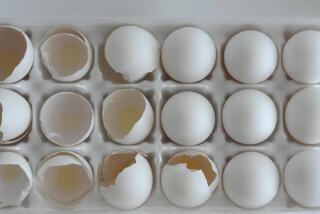The Butter Truth
- Share via
Butter, for centuries a symbol of the good life, is again becoming a luxury item. Prices at local grocery stores last weekend ranged as high as $4.48 a pound--more than twice last year’s prices.
The culprit? Any of several things. Or, more likely, all of them.
In the first place, the price of butter always goes up in the summer. Demand for butterfat increases because ice cream production picks up (ice cream manufacturers are among the largest consumers of butterfat). At the same time, production drops. Hot cows are not happy milkers.
Right now, demand for butterfat is higher than it’s ever been, even considering the season. People no longer seem to be so wary of fat. Although the demand for table butter has increased only a modest 3% during the last seven years, according to the American Butter Institute, demand for ice cream has jumped 10% and cream cheese is up 43%.
At the same time, this year’s production drop was exaggerated by the effects of--you guessed it--El Nino. California produces roughly 20% of the milk in the country, and the main dairy counties (Tulare, Merced and Stanislaus) were mired in mud for much of the spring. Cows are not happy milkers when ranchers are having a hard time getting feed out to them in the mud.
Federal agricultural policies play a part as well. To encourage exports and help balance the trade deficit, the government has been paying a subsidy to farmers who ship their butter out of the country.
The bottom line is that the commodities price for Grade AA butter on the Chicago Mercantile Exchange shot up to $2.07 a pound last week. That’s almost double the $1.10 a pound it was at the same time last year.
This has created a ripple effect through the dairy economy. With so much pressure on butter, cheese prices are also increasing, as are milk prices.
How long will this go on? At least through the summer, most economists agree.
At that point, opinions diverge. Some say higher prices will curb demand and at the same time spur production, bringing lower prices. Others say these prices are here to stay, because structural changes in the dairy industry--the result of collapsing demand for nonfat dried milk--mean that the lower production of butter will continue.
*
Farmers’ Market Report:
At the Thursday morning market in Carson, exotic vegetables are the big draw. At Top-Veg, which farms locally, there were black radish, kabocha squash, bitter melon, okra, lamb’s quarters and dandelion greens. Andre’s Farm in Tulare County had shoots of bitter melon, juke, okra, beans and yams, as well as Chinese okra, Asian horseradish and opo. Chee Farms from Fresno had light purple long Chinese eggplant, dark purple long Japanese eggplant, green and light purple long Filipino eggplant and light purple round Indian eggplant, as well as all kinds of shoots and squash.
More to Read
Inside the business of entertainment
The Wide Shot brings you news, analysis and insights on everything from streaming wars to production — and what it all means for the future.
You may occasionally receive promotional content from the Los Angeles Times.










